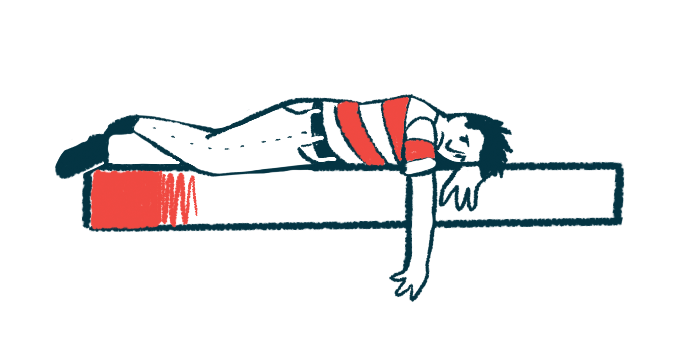Poor sleep quality linked to reduced physical activity in axSpA: Study
'Extent and magnitude' of sleep problems may amplify inflammation in patients

Poor sleep quality is highly prevalent among people with axial spondyloarthritis (axSpA) who have moderate to high disease activity and who don’t practice regular physical exercise, a study from Scandinavia reports.
More physical activity and greater cardiorespiratory fitness were associated with better sleep.
“The extent and magnitude of reduced sleep quality found in this study require attention, as unmanaged sleep problems can amplify the systemic inflammation of the disease and pain sensitivity, and cause poor quality of life for individuals living with axSpA,” the researchers wrote.
“Our findings emphasize the need to routinely assess sleep quality in axSpA patients with moderate to high disease activity,” the team added.
The study, “Reduced sleep quality is highly prevalent and associated with physical function and cardiorespiratory fitness in patients with axial spondyloarthritis: a cross-sectional study” was published in the Scandinavian Journal of Rheumatology.
85% of patients in study found to have reduced sleep quality
axSpA is a type of chronic arthritis that mainly affects joints in the spine, pelvis, and chest. It includes nonradiographic axSpA (nr-axSpA), where no damage is visible on an X-ray, and radiographic axSpA (r-axSpA), also known as ankylosing spondylitis, where such damage is visible.
Sleep problems are common among people with axSpA, which may add to other physical symptoms in impairing function.
However, evidence on how frequent poor sleep is among these patients is lacking, as is data on how physical performance, cardiorespiratory fitness and spinal mobility affect sleep quality.
To learn more, researchers in Norway and Sweden analyzed data from the Exercise for SpondyloArthritis (ESpA) trial (NCT02356874), launched in 2015. It compared the impact of no exercise with that of three months of supervised, high-intensity cardiorespiratory and strength exercise on disease activity.
In total, 99 of 100 axSpA patients enrolled in the ESpA trial had sleep data available and were included in the analysis. Overall, just more than half of the study’s participants (53%) were women, and their mean age was 46.
Most patients had ankylosing spondylitis (70%) and high disease activity (72%), as assessed by the AS Disease Activity Score based on C-reactive protein. Treatment with tumor necrosis factor inhibitors, a group of biological medications used to treat inflammatory conditions, was administered to 44% of the patients.
Sleep quality was assessed by the Pittsburgh Sleep Quality Index (PSQI), a questionnaire that evaluates 19 items related with sleep quality over one month. Scoring ranges from 0 to 21, with lower scores corresponding to better sleep.
In total, 84 patients (85%) had reduced sleep quality, defined by the mean PSQI score. More specifically, 65% of patients reported sleep disturbances, followed by poor subjective sleep quality (54%), daytime dysfunction (41%), and sleep latency (41%), among others. Sleep latency is the time it takes a person to fall asleep.
Sleep medications were used by 18 patients.
Researchers say improving physical function is key to better sleep
Compared with the group that experienced reduced sleep quality, those with normal sleep had significantly better performance-based physical function. This was evidenced by a higher mean score in the Ankylosing Spondylitis Performance Index (ASPI) — 28.9 versus 34 seconds. The ASPI involves three tests: bending and picking up six pens from the floor, getting up from the floor when lying on the back, and putting on a pair of socks.
Patient-reported physical function, assessed by the Bath Ankylosing Spondylitis Functional Index (BASFI), also was significantly better — meaning scores were lower, with a mean of 2.4 versus 3.7 — for those with normal sleep, . BASFI includes eight items related to activities of daily living and two items addressing participation.
Those with normal sleep had significantly better cardiorespiratory fitness, as evidenced by a higher mean peak oxygen (VO2peak) uptake during a treadmill test (37.4 vs. 34.6 millilitres per kilogram per minute).
The results of this study demonstrated that sleep problems are highly prevalent and that several aspects of sleep quality, such as sleep disturbances, daytime dysfunction, and sleep latency, are frequently reported in axSpA patients with moderate to high disease activity who do not engage in regular exercise.
In statistical analyses, all three parameters — ASPI, BASFI, and VO2peak — were significantly associated with PSQI. After taking into account disease activity and immunosuppressive medications, only VO2peak was no longer statistically associated with PSQI.
“The results of this study demonstrated that sleep problems are highly prevalent and that several aspects of sleep quality, such as sleep disturbances, daytime dysfunction, and sleep latency, are frequently reported in axSpA patients with moderate to high disease activity who do not engage in regular exercise,” the researchers wrote.
“Furthermore,” the team added, “the results showed that better physical function and higher cardiorespiratory fitness were significantly associated with better sleep quality.”
No correlation was found between spinal mobility and sleep quality, they noted.
Overall, “these findings indicate that interventions aimed at improving physical function and cardiorespiratory fitness may have a beneficial effect on sleep quality in axSpA,” the scientists concluded.








